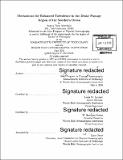Mechanisms for enhanced turbulence in the Drake Passage Region of the Southern Ocean
Author(s)
Merrifield, Sophia Tiare
DownloadFull printable version (25.49Mb)
Other Contributors
Woods Hole Oceanographic Institution.
Advisor
Louis St. Laurent and W. Brechner Owens.
Terms of use
Metadata
Show full item recordAbstract
The Southern Ocean is one of the most energetic regions of the world ocean due to intense winds and storm forcing, strong currents in the form of the Antarctic Circumpolar Current (ACC) interacting with steep topography, and enhanced mesoscale activity. Consequently, the Southern Ocean is believed to be a hotspot for enhanced oceanic mixing. Due to the remote location and harsh conditions, few direct measurernents of turbulence have been collected in the Southern Ocean. Previous studies have used indirect methods based on finestructure observations to suggest that strong mixing is ubiquitous below the mixed layer. Results from a US/UK field program, however, showed that enhanced internal wave finestructure and turbulence levels are not widespread, but limited to frontal zones where strong bottom currents collide with steep,, large amplitude topography. This thesis studies the processes that support turbulence and mixing in the surface boundary layer and at intermediate depths in the Drake Passage region. Direct measurements of turbulence show that previous estimates of mixing rates in the upper 1km are biased high by up to two orders of magnitude. These biases are discussed in the context of the internal wave environment and enhanced thermohaline finestructure. The dissipation rate of thermal variance is enhanced in the upper 1000m, with the highest values found in northern Drake Passage where water mass variability is the most pronounced. Double diffusive processes and turbulence both contribute to buoyancy flux, elevating the effective mixing efficiency above the canonical value of 0.2 in the upper 1km. Despite the prevalence of energetic wind events, turbulence driven by downward propagating near-inertial wave shear is weak below the mixed layer. The results of this study inform large-scale modeling efforts through parameterizations of mixing processes in the highly undersampled Southern Ocean.
Description
Thesis: Ph. D., Joint Program in Physical Oceanography (Massachusetts Institute of Technology, Department of Earth, Atmospheric, and Planetary Sciences; and the Woods Hole Oceanographic Institution), 2016. Cataloged from PDF version of thesis. Includes bibliographical references (pages 125-134).
Date issued
2016Department
Joint Program in Physical Oceanography; Woods Hole Oceanographic Institution; Massachusetts Institute of Technology. Department of Earth, Atmospheric, and Planetary SciencesPublisher
Massachusetts Institute of Technology
Keywords
Joint Program in Physical Oceanography., Earth, Atmospheric, and Planetary Sciences., Woods Hole Oceanographic Institution.